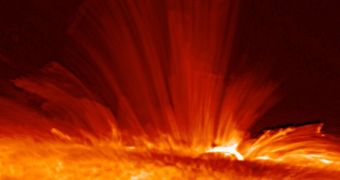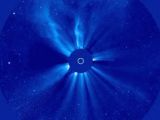JAXA launched the Hinode solar space observatory in September 2006 and is equipped with several instruments such as the solar optical telescope, an X-ray telescope and an EUV imaging spectrometer with which it can conduct investigations on the Sun's atmosphere but also on its interior, in order to establish the origin of the magnetic field, the unusual high temperature experienced in the corona and the phenomenons which determine the solar eruptions.
In Japanese, Hinode basically means sunrise. Since its launch and orbit insertion the Hinode spacecraft attacked the problems relating multiple areas of solar physics. The collected data is now presented in a special feature of the Astronomy and Astrophysics magazine appearing this week.
Most of the collected data is related to the physics behind the appearance and dynamics of sunspots, corona dynamics and the magnetic flux on the surface. The few scientific papers about sunspots present today highlight the structure of the penumbra and the feature surrounding the cone of the sunspots. Hinode suggests that the penumbra is defined by magnetic flux tubes, extending high above the surface of the Sun before connecting with other magnetic features on the Sun's surface.
Also investigations into the solar atmosphere, and solar corona in special, reveals that currently available models are not accurate enough to describe solar flares. According to data provided by Hinode, solar flares cannot be associated with the occurrence of microflares, however further soft X-ray investigations are required before making a clear difference between a solar flare and a microflare.
Although the data released this week is only a small part of the research conducted with Hinode, it is a valuable new insight into the layers of the Sun's atmosphere, starting with the photosphere and ending with the corona. The new observations related to the structure and the dynamics of the solar atmosphere brings significant new understanding into stellar atmospheres in general.

 14 DAY TRIAL //
14 DAY TRIAL // 
